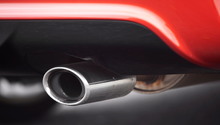Honda Accord: Exhaust Modifications
Most factory exhaust systems are highly restrictive; therefore, a modified aftermarket exhaust could further enhance your engine's performance.
This article applies to the Honda Accord (1990-2002).
The exhaust is a system of pipes (located underneath a vehicle) that transfers gases to and out of the tail pipes. Unfortunately, a reduction in exhaust flow occurs due to "back pressure," whereby narrow pipes resist a higher amount of gas emission. The Accord's stock exhaust system was not meant to increase sound and horsepower; therefore, big gains can be achieved by modifying the stock system. This article discusses how headers, axle-back and cat-back pipes, as well as exhaust tips could improve your vehicle's performance. It also provides skill levels required to complete the job, DIY and professional costs of installation.
Exhaust Modifications
Upgrading the exhaust is one way to increase your numbers during a Dyno test. The increase in airflow will improve your engine's capacity to deliver a higher performance—both in horsepower and torque. A few shops in the USA have the equipment for a Dyno test, but this is a great way to yield accurate results for your car.

Headers

DIY Cost – $92-900 for parts
Professional Cost – $150-350 for labor
Skill Level – Moderate; this might be a simple bolt-on, but it still requires familiarity with components under the car. Plus, this job is better completed with the help of a second person.
Headers make it easier for the engine to push exhaust gases out of the cylinders. It connects to the rest of the exhaust system as it travels to the back of the car. A performance header increases horsepower because it has larger diameter pipes. The most reputable header manufacturers back up their claims with Dyno sheets, which provide the test results of increased horsepower.
Featured Video: How to Install a Header
Axle-Back and Cat-Back Pipes

DIY Cost – $220-900 (Axle-Back) and $105-1,300 (Cat-Back)
Professional Cost – $50-100 for labor
Skill Level – Difficult; this is a two person job. Depending on the model, it may involve welding and other specialty tools.
Regardless of which kind, the back pipe's job is to reduce restrictive elements near the end of an exhaust system. The axle-back pipe starts from the rear axle to the back bumper, and the cat-back pipe begins at the very end of the catalytic converter, but it also travels to the back bumper. Most Honda forum members favor axle-back pipes because they add more horsepower and create a louder sound; however, a cat-back exhaust can still deliver comparable performance.
Exhaust Tips

DIY Cost – $20-150 for parts
Professional Cost – $25-50 for labor
Skill Level – Simple to moderate; installation could require only a screwdriver, but it may also involve welding.
Exhaust tips are a fast, inexpensive way to add some flair and style to your Accord. While they don't offer any documented horsepower or torque gains, high quality and well designed tips could amplify the sound that comes out of the pipe, causing your exhaust to sound louder and more refined.
Pro Tips
- Most exhaust systems require a full vehicle lift and some welding, so a second person is necessary for installment.
- It's wise to get a quote from your local auto shop before purchasing an exhaust system to make sure they can perform the installation. As a vital component of your car, it will perform properly if it is installed correctly.
Related Discussion and Site
- Axle-back and Cat-back Exhausts - APtuned.com
- '99 Accord Mods - Honda-Tech.com






